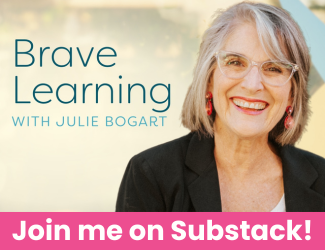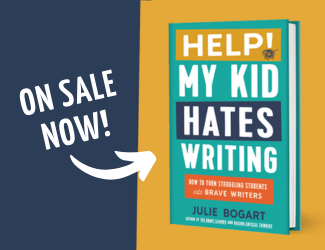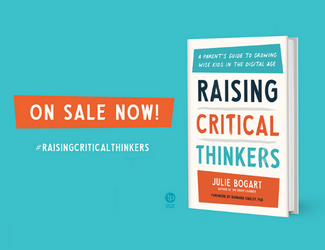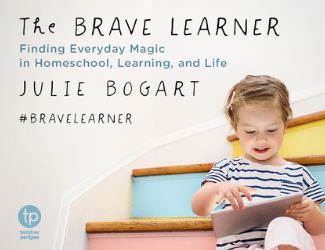Hello everyone!
Summer is long over. However, fall is just beginning in the Bogart household. My middle child only moved to college on Thursday! Made it very hard to settle into a fall routine.
Now that we’re here, let’s explore a few thoughts about Brave Writer and writing that may support your coming school year. One of our Brave Writer moms said it well a few years back:
I saw the name “Brave Writer” and honestly didn’t even consider why the website was called that. After reading what a friend had to say about The Writers Jungle on the Sonlight forums, I decided to check it out. At first I thought…no, way…the price is too much! Boy was I wrong! It has been one of the most valuable investments I have made on this homeschool journey.
Last week I finally realized the significance of the name “Brave Writer.” It speaks not only to the bravery of putting your thoughts down on paper, but also to me as a homeschool mom. I have been using several recommended curriculum including a spelling workbook. It has gone fine—my ds 8 has been getting great grades on the tests as well as learning some alphabatizing and proofreading skills. However, when he writes, he misspells some of those same words. There is a disconnect with my ds between completing a workbook and memorizing a list of spelling words and actually being able to spell well. Another downside…the spelling workbook pages were taking way too long some days with a dawdling boy (but who could blame the kid! It’s not the most fascinating work!). And that’s when I did my first brave thing…I threw out the spelling workbook (gasp, and the $10 I had paid for it).
O.K…that may not seem that brave, but it was my security blanket! And now I am having these crazy thoughts concerning the Grammar book as well. You see, I want him to spend more time on copywork, dictation, narrations, reading great books and poetry and there are just so many hours in the day (especially productive hours where an 8 year boy is involoved).
I’m having trouble letting go of those nagging thoughts “Well, so-and-so is having her ds do the whole grammar book and talks about how much he is learning…what if we don’t? Will he still get into a good college someday? What if he can’t diagram a sentence?” (As I write this, I realize just how silly that sounds, but deep down I still wonder).
So I’m starting with my first brave act…I’m throwing out the spelling workbook and trying a more natural approach using copywork and dictation. Maybe soon I’ll be able to take the next brave step with a little encouragement!
Kay
By the way, my ds doesn’t hate to write now that we do freewriting. I never realized how much pressure he was feeling because he thought everything had to be perfect! Thanks, Julie!
What a great story! It’s true that being brave is not just about writing. It’s about taking calculated risks to trust that writing can be as natural a process as learning to speak was. Kay’s journey can be yours! Every day I hear from families who have completed the homeschooling journey. Here are a couple of their comments:
Hi Julie
We’ve been with Brave Writer for many years: have won a competition, participated in an on-line class, and my daughter is still loving her writing. She’s 17 now…
We’ve loved your stuff and continue to recommend your services to people everywhere we go.
God bless,
Anna
—
I thoroughly appreciated your blog, bravewriter manual and especially the “tuesday teatime” idea. We have enjoyed poetry with chocolate cake and have good memories for that. You helped me approach an area I did not have confidence in so THANK YOU.
🙂Jenny
—
Dear Julie,As a homeschool family, we have been so blessed by you. I just want to thank you so much for what you have done for our family, over the past few years of our subscription.
As you know, children grow up. Our two are at the end of their homeschool journey, and we are using less and less homeschool curriculum, and more and more of community based learning prorams.
We have all ( me too) enjoyed the bravewriter lifestyle, and will always cherish special memories of reading aloud, and poems with our afternoon tea and candles. You are such a huge blessing.
Thank you for everything.
Sincerely,
Beverley
It’s great to be a part of these journeys. Hope Brave Writer can help you too!
























